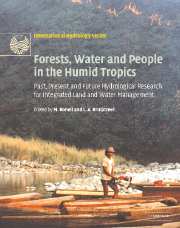 Forests, Water and People in the Humid Tropics
Forests, Water and People in the Humid Tropics Book contents
- Frontmatter
- Contents
- List of contributors
- Foreword
- Preface
- Acknowledgements
- Symposium and Workshop
- Introduction
- Part I Current trends and perspectives on people–land use–water issues
- Part II Hydrological processes in undisturbed forests
- Part III Forest disturbance, conversion and recovery
- 19 Natural disturbances and the hydrology of humid tropical forests
- 20 Spatially significant effects of selective tropical forestry on water, nutrient and sediment flows: a modelling-supported review
- 21 Effects of shifting cultivation and forest fire
- 22 Soil and water impacts during forest conversion and stabilisation to new land use
- 23 Large-scale hydrological impacts of tropical forest conversion
- 24 Forest recovery in the humid tropics: changes in vegetation structure, nutrient pools and the hydrological cycle
- 25 The hydrological and soil impacts of forestation in the tropics
- 26 The potential of agroforestry for sustainable land and water management
- Part IV New methods for evaluating effects of land-use change
- Part V Critical appraisals of best management practices
- Conclusion: Forests, water and people in the humid tropics: an emerging view
- Plate section
- References
25 - The hydrological and soil impacts of forestation in the tropics
from Part III - Forest disturbance, conversion and recovery
Published online by Cambridge University Press: 12 January 2010
- Frontmatter
- Contents
- List of contributors
- Foreword
- Preface
- Acknowledgements
- Symposium and Workshop
- Introduction
- Part I Current trends and perspectives on people–land use–water issues
- Part II Hydrological processes in undisturbed forests
- Part III Forest disturbance, conversion and recovery
- 19 Natural disturbances and the hydrology of humid tropical forests
- 20 Spatially significant effects of selective tropical forestry on water, nutrient and sediment flows: a modelling-supported review
- 21 Effects of shifting cultivation and forest fire
- 22 Soil and water impacts during forest conversion and stabilisation to new land use
- 23 Large-scale hydrological impacts of tropical forest conversion
- 24 Forest recovery in the humid tropics: changes in vegetation structure, nutrient pools and the hydrological cycle
- 25 The hydrological and soil impacts of forestation in the tropics
- 26 The potential of agroforestry for sustainable land and water management
- Part IV New methods for evaluating effects of land-use change
- Part V Critical appraisals of best management practices
- Conclusion: Forests, water and people in the humid tropics: an emerging view
- Plate section
- References
Summary
INTRODUCTION
In response to the continuing degradation and disappearance of the world's tropical forests (Drigo, this volume) the establishment of plantation forest on degraded and previously forested sites as well as into (sub)tropical grasslands is becoming increasingly common (Evans, 1999). The hydrological effects of this practice and the potential of forestation to improve or restore the hydrological behaviour of degraded catchments constitute the prime focus of this chapter, expanding and updating an earlier review of the subject by Bruijnzeel (1997). Three aspects are highlighted in particular, namely: (i) the effects of tree plantations on annual and seasonal streamflow totals; (ii) the associated impacts on stormflow and sediment production; and (iii) concurrent changes in soil chemical characteristics (fertility). Because the hydrological changes associated with forest clearing and the establishment of a new vegetation cover during the first few years are discussed at length in the chapter by Grip, Fritsch and Bruijnzeel, much of what follows pertains to the post-canopy closure phase of plantations.
EXTENT, DEVELOPMENT AND IMPORTANCE OF TROPICAL TREE PLANTATIONS
The establishment of timber plantations is a notable and accelerating land-use development of the last half-century. It has been estimated that there are now some 40 to 50 million ha of forest plantations in the tropics and warmer subtropics, trees being planted nowadays at a rate of c. 2 million ha yr-1 compared to c. 1 million ha yr-1 a decade ago (Evans, 1999). One of the most widely used types of tree is the eucalypt (Eucalyptus spp.).
- Type
- Chapter
- Information
- Forests, Water and People in the Humid TropicsPast, Present and Future Hydrological Research for Integrated Land and Water Management, pp. 622 - 651Publisher: Cambridge University PressPrint publication year: 2005
References
- 42
- Cited by


